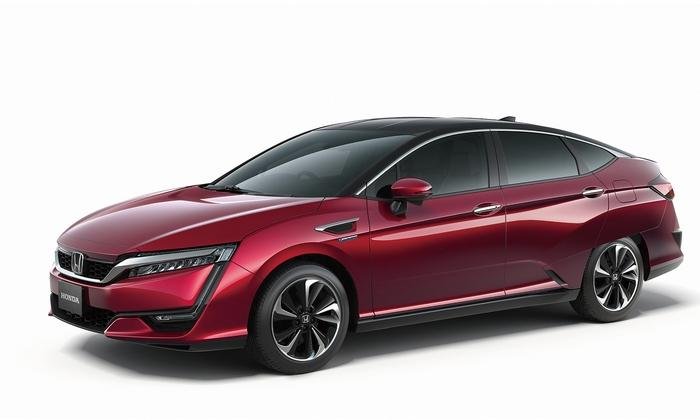Honda Will Show Fuel Cell, Autonomous Driving Vehicles in Tokyo

Both vehicles tap wider industry trends toward zero-emissions drivetrains and self-driving technologies.
The tentatively named FCV fuel cell vehicle is a pre-production prototype of the five-seat hydrogen-powered sedan expected to go on sale next year. It gets slightly toned-down sheet metal from the sleek futuristic concept that Honda unveiled in November 2014.
Honda’s booth-like Wander Stand autonomous driving concept is a compact, joystick-equipped two seater that deploys the company’s Omni Traction Drive System to move in any direction, even sideways.
FCV vs. Mirai
Honda’s upcoming hydrogen car follows this year’s release of the Mirai hydrogen fuel cell vehicle from Japanese rival Toyota Motor Corp.
Honda said it expects its FCV production model to deliver a full-tank driving range of more than 700 kilometers (435 miles) and a refueling time of three minutes. That compares with the Mirai’s 312-mile range.
The FCV is also lower, wider and longer than the Mirai, and seats five to the Mirai’s four.
Honda said its fuel cell vehicle achieves a truer low-hood sedan silhouette thanks to a downsized fuel cell stack that fits compactly into a normal-sized engine bay.
The stack generates 130 kilowatts at a power density of 3.1 kilowatts per liter. Electricity is stored in lithium ion batteries that power the wheels through a 130-kilowatt motor.
Compact stack
Honda said it reduced the size of the new fuel cell stack by a third, from its previous generation technology, so that it is about as big as a 3.5-liter V-6 gasoline engine.
That will enable Honda to deploy the power plant in various vehicle types, which will help popularize the technology, the carmaker said. Placement of the entire stack under the hood also allowed Honda to free up cabin space and squeeze in the fifth seat.
Many automakers are positioning hydrogen fuel cell vehicles as a future alternative drivetrain. The systems generate electricity through a chemical reaction in the fuel stack between hydrogen and air. Heat and water vapor are the only emissions.
But making the costly systems practical remains a challenge, and has led to tie-ups in developing the technology. Honda has already teamed with General Motors to develop a next-generation hydrogen fuel cell system due around 2020. Toyota is cooperating with Germany’s BMW AG, and Nissan Motor Co. has partnered with Daimler AG and Ford Motor Co.
Honda introduced its first fuel cell vehicle in 2002. GM launched a test fleet of hydrogen-powered Chevrolet Equinox crossovers in 2007. Also in the game is Hyundai Motor Co., which began leasing its hydrogen Tucson compact crossover in California in 2014.
‘Modern lounge’
Honda said its latest FCV’s exterior design is based on a “bold and aero” concept to deliver a low, wide stance and sleek profile. The gaping front side-gills of the earlier concept have been mainstreamed, as have some of that rendition’s character lines.
But the overall look cleaves close to last year’s concept, with slightly trimmed rear wheel flaps covering just the tips of its 18-inch aluminum wheels.
“We sought beauty as a sedan as well as a sprit of innovation befitting a model that breaks through to new age,” Honda said in a statement.
Inside, the cabin aspires to be an “advanced modern lounge,” with warm-feeling, high-quality materials and a clean simple design that creates spaciousness, Honda said.
Honda also is highlighting the FCV’s dual use as an emergency power source, a point particularly salient in disaster-prone Japan, notorious for its earthquakes, volcanoes and tsunamis. In a crisis, the fuel cell stack transforms into a “movable power station,” that can be connected to outside devices and power a typical home for seven days, Honda said.
Honda unveiled the previous concept late last year and promptly said that the company was pushing back its on-sale date as part of a global product quality review.
It said it aimed to introduce the car in Japan by the end of March 2016 and in the U.S. and Europe afterward. Previously, Honda had said the car would go on sale in Japan and the U.S. in 2015.
Free mobility
The Honda Wander Stand is the automaker’s latest experiment in the realm of autonomous driving.
 The concept uses the same omnidirectional in-wheel motor system that propels Honda’s Uni-Cub personal mobility device. The Uni-Cub is a kind of motorized stool that people can steer in any direction simply by tilting their bodies. Think Segway with a seat.
The concept uses the same omnidirectional in-wheel motor system that propels Honda’s Uni-Cub personal mobility device. The Uni-Cub is a kind of motorized stool that people can steer in any direction simply by tilting their bodies. Think Segway with a seat.
The Wander Stand aims to explore “free mobility” through a self-driving mode that allows the riders to connect with the outside world through onboard telematics. The windshield, for example, acts as a giant head-up display to enable navigation, phone calls and e-mail.
Hybrid Odyssey?
Also in Tokyo, Honda will display a hybrid version of its Japan-market Odyssey minivan, which is different from the North American vehicle of the same name. It gets an updated version of the two-motor electric-gasoline powertrain used in the Accord Hybrid.
That vehicle is expected to go on sale in Japan next spring. A Honda spokeswoman declined to comment on whether the U.S. Odyssey would be getting a hybrid variant.
